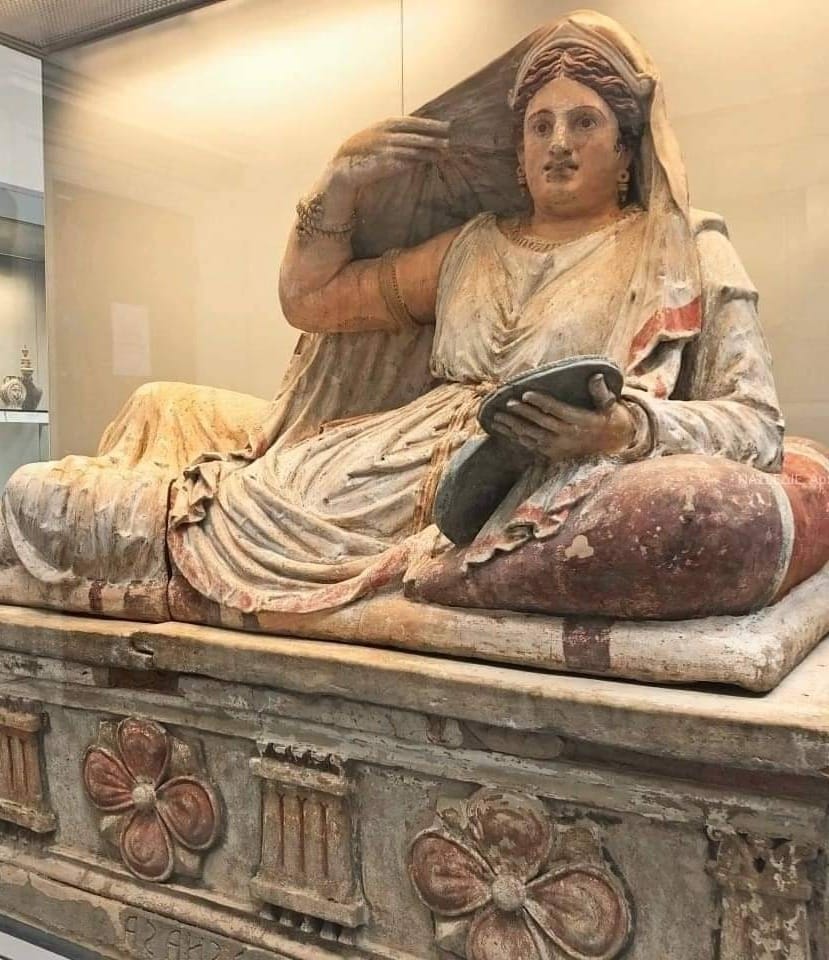The sarcophagus of Seianti Hanunia Tlesnasa, discovered amidst the picturesque surroundings of Poggio Cantarello in Tuscany and dating back to 150–140 BC, stands as a testament to the extraordinary artistry and cultural depth of the Etruscan civilization. This remarkable terracotta masterpiece, now preserved in the British Museum, continues to captivate historians, archaeologists, and visitors alike with its intricate craftsmanship and profound symbolism.
The Story of Seianti Hanunia Tlesnasa
Seianti Hanunia Tlesnasa, whose name is elegantly inscribed in Etruscan script on the sarcophagus, belonged to one of the wealthiest families in Chiusi, a prominent Etruscan city. The elaborate design and grandeur of the sarcophagus unmistakably reflect her elevated social status. At the same time, it offers a glimpse into the sophistication and devotion to the afterlife that characterized Etruscan funerary practices. For the Etruscans, the afterlife was a continuation of earthly existence, and honoring the deceased with lifelike representations and elaborate tombs was a central aspect of their cultural and religious beliefs. Seianti’s sarcophagus beautifully encapsulates these values, serving as both an artistic masterpiece and a vessel of memory.

An Insight into Etruscan Society and Beliefs
The depiction of Seianti reclining gracefully on a shallow mattress, supported by a plush pillow, is strikingly lifelike and evocative of scenes of banquets and leisure often portrayed in Etruscan art. This pose conveys a sense of comfort, ease, and eternal repose, illustrating how the Etruscans envisioned the afterlife—a continuation of earthly joys and pleasures. The detail of an open-lidded mirror in her hand further enriches the narrative. This accessory, emblematic of femininity, self-reflection, and possibly vanity, offers a deeply personal glimpse into the societal values and gender roles of the time. Her other hand, delicately adjusting her cloak, imparts a sense of natural movement, imbuing the sculpture with vitality and grace.
The Richness of Etruscan Attire
The detailed depiction of Seianti’s attire is a masterpiece in itself, reflecting not only her high social standing but also the technical prowess of Etruscan artisans. She is dressed in an ornate gown and a flowing cloak, rendered with such finesse that the folds of the fabric appear to ripple naturally. This lifelike representation of textiles underscores the Etruscan mastery of terracotta as a medium. Her accessories—an elegant tiara, intricate earrings, bracelets, and a necklace—further emphasize her elite status and offer insights into the wealth and fashion of the Etruscan upper class.
Discoveries Inside the Sarcophagus
The discovery of Seianti’s skeletal remains within the sarcophagus added a layer of authenticity and historical significance to the artifact. Analysis revealed that she was a woman who lived to the age of approximately 50–55 years—an impressive lifespan during a period when life expectancy was generally much shorter. This revelation not only highlights her personal story but also provides a rare glimpse into the health, longevity, and societal roles of Etruscan women. Her life and death are eloquent reflections of a society that valued its women and commemorated their existence through art and ritual.
The Artistic Legacy of the Etruscans
Seianti’s sarcophagus is a shining example of Etruscan art’s influence, blending Greek and Italic traditions into a style that was both distinctive and innovative. The reclining pose, symbolic motifs, and use of terracotta would go on to inspire Roman funerary art. The Romans adopted and adapted many Etruscan conventions, ensuring that the artistic and cultural achievements of this ancient civilization continued to resonate long after its decline. This continuity demonstrates the enduring impact of Etruscan art on the broader cultural landscape of pre-Roman and Roman Italy.
A Window into Etruscan Life and Culture
The sarcophagus of Seianti Hanunia Tlesnasa is far more than a visually stunning artifact. It is a narrative deeply intertwined with the social structures, religious beliefs, and artistic achievements of the Etruscan people. Its lifelike representation of Seianti not only immortalizes her image but also conveys the values and traditions of her time. Through this artifact, modern audiences are offered a tangible connection to a sophisticated society that thrived in pre-Roman Italy.
Continued Inspiration and Understanding
Today, the sarcophagus remains a centerpiece of the British Museum’s collection, drawing thousands of visitors who marvel at its artistry and historical significance. For scholars, it provides invaluable insights into the cultural and religious practices of the Etruscans, particularly their perceptions of identity, gender, and the afterlife. For casual observers, it serves as a poignant reminder of the universality of human experiences—of life, death, and the enduring desire to be remembered.
In preserving and displaying artifacts like Seianti’s sarcophagus, institutions like the British Museum ensure that the rich history and cultural contributions of the Etruscan civilization continue to inspire and educate future generations. The artistry and symbolism captured in this single piece reveal a culture deeply attuned to the interplay of life and death, memory and legacy, individuality and community.
Through the sarcophagus of Seianti Hanunia Tlesnasa, we are invited to explore not only the life of a remarkable woman but also the broader narrative of a civilization whose artistic and cultural achievements laid the foundation for much of what we recognize in Western art and tradition today. This terracotta masterpiece remains a timeless testament to the creativity and humanity of the Etruscans, bridging the gap between ancient and modern worlds.





